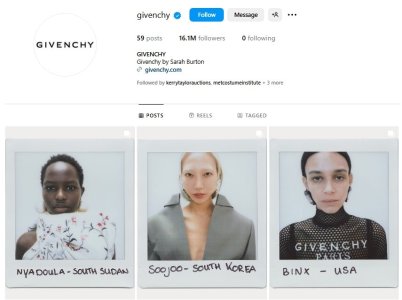The Making of Sarah Burton’s Givenchy
By Nicole Phelps
March 6, 2025
 Sarah Burton at work in the studio.Photo: David Burton/Courtesy of Givenchy
Sarah Burton at work in the studio.Photo: David Burton/Courtesy of Givenchy
It’s late January, a full month and then some before Sarah Burton’s fall 2025 Givenchy debut, and an entire wall of trial looks is arranged with meticulous precision at the house’s Avenue Georges V atelier, in the order that they may walk down the runway in March during Paris Fashion Week. Burton was appointed in September, but she has more than just the last six months of prep time on her side. She hails from Alexander McQueen, where she started as Lee’s assistant—during her former boss’s own Givenchy tenure circa 1997 she was charged with bringing show pieces back and forth from London to Paris—and eventually stepped into his shoes. By the end of her 26-year tenure there in 2023 she was so beloved, so respected, her exit precipitated an industry-wide outcry, lamenting the lack of women creative directors at the top houses.
Now, all of a sudden, experience very much matters in designer hires. Burton’s fellow 50-somethings Alessandro Michele and Peter Copping have been installed at Valentino and Lanvin, reversing trends that saw disruptor designers and number twos get the plum jobs in the last couple rounds of musical chairs, and Haider Ackermann, another Gen X designer, made his own debut at Tom Ford yesterday, two days before Burton’s Givenchy unveiling.
To Burton, Givenchy is the plummest of assignments. “For me, there’s always a juxtaposition to what I do: you have the dress and the tailoring, and I love that this house has both of those things in its DNA. It felt like it was a great place to be.” Though that may be true, she’s arrived at a moment when that house DNA has become a bit muddled, following the tenures of Matthew M. Williams and Clare Waight Keller. You could describe Givenchy’s last six years as a long period of soul searching, with only limited clarity.
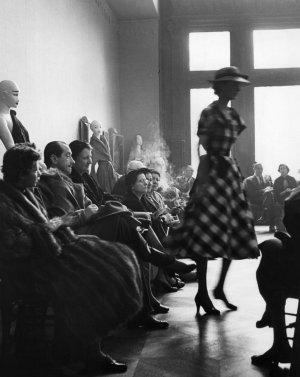 Hubert de Givenchy’s first show in 1952 was held in a hôtel particulier on rue Alfred de Vigny, christened by a journalist at the time “the Cathédrale,” Martin Dutkovitch/Getty Images
Hubert de Givenchy’s first show in 1952 was held in a hôtel particulier on rue Alfred de Vigny, christened by a journalist at the time “the Cathédrale,” Martin Dutkovitch/Getty Images
And so Burton has opted to go back to the beginning—to Hubert de Givenchy’s first show in 1952. Studying black-and-white photographs of his debut, which was held in a hôtel particulier on rue Alfred de Vigny, christened by a journalist at the time “the Cathédrale,” she was struck by Givenchy’s youth—he was just 25—and by the obvious camaraderie between the couturier and his models, among them Bettina Graziani, who also worked in his press office. “But what really amazed me,” Burton says, “was how graphic the collection was; it’s very stripped back, not fussy. For me, Givenchy—it is silhouette.”
Quite serendipitously, during a renovation of that hôtel particulier, a stash of trash bags containing archival patterns from Givenchy’s first collection were discovered inside a wall—“like a gift,” Burton says. She has one of them on display in her light-strewn office; it sits on a table opposite a large window that frames the Eiffel Tower, the kind of view that Parisians take for granted, but can stop a visitor in her tracks. But there’s no one-to-one correspondence between the treasure trove of old patterns and what you’ll see on the runway tomorrow. “I haven’t used them and made them again; I think you have to go back, but you also have to go forward. But I love the idea that they exist; they’re kind of a magical thing,” Burton says.
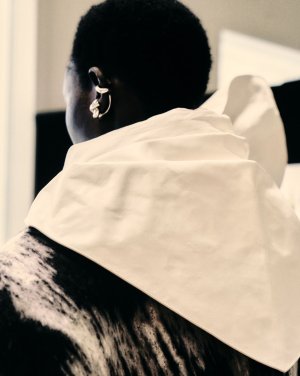 A preview of the new collection. Photo: Heikki/Courtesy of Givenchy
A preview of the new collection. Photo: Heikki/Courtesy of Givenchy
 The dresses seem made to defy gravity, strapless puff balls of tulle and chopped-off “super, super-mini” dresses, without any ornamentation. Photo: Heikki/Courtesy of Givenchy
The dresses seem made to defy gravity, strapless puff balls of tulle and chopped-off “super, super-mini” dresses, without any ornamentation. Photo: Heikki/Courtesy of Givenchy
The patterns, which are now in the process of being restored, confirmed for her that, despite his famous association with Audrey Hepburn and Breakfast at Tiffany’s, Givenchy didn’t begin with ruffles and bows and lace. “It started quite clean, quite pure and, not back-to-basics, but it’s obviously post-war,” says Burton. “There’s a kind of simplicity.”
Where Givenchy had Hepburn, Burton has Cate Blanchett and Rooney Mara and her longtime stylist Camilla Nickerson, who wears her McQueen pantsuits like a kind of uniform. Cut—finding the shoulder, the waist, the pant shape that will define her Givenchy, down to the seams—has been Burton’s top priority since her arrival. During her time off between jobs she rented a small studio in London where she sketched, sewed, and got back to “understanding why you did it all at the beginning.” Here at Givenchy, she began by sketching before moving into the atelier to drape with the team.
A black double-breasted tuxedo jacket looks soft and strong at once—it’s a little like Burton’s own personality—with big, rounded shoulders, a pronounced hourglass waist, and sleeve seams that twist around the arm. “I cut the sleeve on a curve, and then pressed it so you have this very feminine shape, I call it a couture seam,” she says, pointing out that the jackets are tailored by women’s pattern makers but made with menswear construction. “I like the idea of both working hand-in-hand, because men’s construction is quite different from women’s construction in tailoring—the way that you press the garment and canvas it.”
She’s designed some of the jackets inside-out, with exposed seams and hems that have been left raw and frayed, but because of the canvas they have a substance, a chic gravitas. “A lot of the time people say, ‘okay, what’s it going to look like in a picture?’ And I say, ‘what’s it going to look like on a woman, and how do they feel in it?’ How do you get the proportion right, so that it looks graphic enough, but it doesn’t overpower the woman? That it feels like there’s a human being in it.”
The dresses, in contrast, seem made to defy gravity, strapless puff balls of tulle and chopped-off “super, super-mini” dresses, without any ornamentation. Pointing to a little black number, Burton says, “it is a little black dress,” the iconic Givenchy item, but maybe the better way to describe it is “the skeleton of one, before it became a little black dress.” The custom-made white lace corseted gown Elle Fanning wore to the Oscars—a preview of Burton’s haute couture, which isn’t likely to appear on a runway until 2026, she says—is far more structured and formal, as the red carpet demands, though her A Complete Unknown cast mate Timothée Chalamet was also in Givenchy, an acidy yellow cropped leather jacket and matching trousers with a silk shirt, that was one of the more relaxed men’s looks of the night.
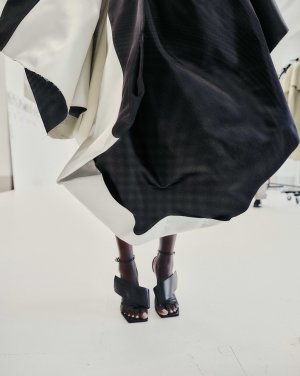 Burton earns her reputation as a hands-on designer all over again at Givenchy. “I think I’m a bit of a train spotter when it comes to all that kind of stuff,” she admits. Photo: Heikki/Courtesy of Givenchy
Burton earns her reputation as a hands-on designer all over again at Givenchy. “I think I’m a bit of a train spotter when it comes to all that kind of stuff,” she admits. Photo: Heikki/Courtesy of Givenchy
On this January studio visit, and again at a preview four days before the show, Burton earns her reputation as a hands-on designer all over again, examining one of those super-minis, for example, and asking, “is the godet in the right place or does it need to be more circular?” “What type of tulle have we put in there, could it be lighter?” “Do we put pockets in it to give it a different attitude?” “I think I’m a bit of a train spotter when it comes to all that kind of stuff,” she admits.
Showing off piece after perfect-looking piece she reiterates the caveat, “it’s still a work in progress.” It’s her practice to do at least three fittings per garment. “That’s 150 fittings between now and Friday,” she says, betraying none of the anxiety a figure like might instill in another person. “This is the fun part,” she says, pinning a swatch of embroidery that looks “aged or slightly destroyed” like it too came out of those trash bags hidden in the wall, to the effusive bow at the neck of a black silk dress. “McQueen was so small, you had to make the patterns yourself. I remember him putting an invisible zip into a bias-cut Prince of Wales skirt. Lee was amazing on the sewing machine, but we only had one meter, so you couldn’t make a mistake.” Of course he didn’t. “That’s how I learned to sort of sew and pattern cut on the job.”
Is there a freedom in reinterpreting Hubert de Givenchy, a designer who retired in 1995, one that few in the industry remember personally? Compared to McQueen, who so many people still hold personally dear? “There’s a pressure to the first show, but you have that everywhere, wherever you go,” says Burton. “I know what I love doing, what I’m good at doing. I learned that with Lee, and then carried on. You have to tell your own stories.”
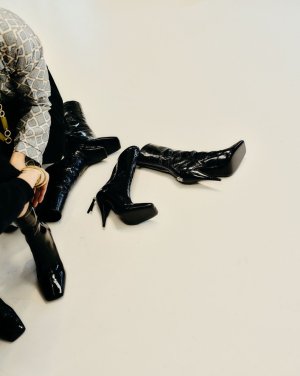 It’s Burton’s practice to do at least three fittings per garment. “That’s 150 fittings between now and Friday,” she said several days before the show, betraying none of the anxiety a figure like might instill in another person. “This is the fun part.” Photo: Heikki/Courtesy of Givenchy
It’s Burton’s practice to do at least three fittings per garment. “That’s 150 fittings between now and Friday,” she said several days before the show, betraying none of the anxiety a figure like might instill in another person. “This is the fun part.” Photo: Heikki/Courtesy of Givenchy
When asked the women designer question—why aren’t there more of them in positions of leadership?—Burton gets personal. “My father grew up during the war; his father was away for six years and he was brought up by women, both grandmothers and his mum, so he always believed women ruled the world. I’m from a very kind of matriarchal background. So I never, ever, ever thought it was a problem. I just presumed that I would be able to have the same opportunity. And I have three daughters. I think it’s important to say that women can do anything. And I really believe that.”
The last Givenchy ready-to-wear show from Williams was held under a tent on the sweeping grounds of Paris’s L’École Militaire. Burton’s will take place in the house’s Avenue Georges V headquarters with a guest list of just 300, and a sense of intimacy evocative of those 1952 black-and-white pictures. Describing the distance between the front row and the models, Burton says the idea is, “how close can we get without being caught on a handbag?”
She is a designer who thinks and works on a human scale—from the staging of the show down to the elasticated waist she’s added to the back of trousers. “Maybe I’m too sensitive sometimes, but when I’m dressing somebody, I want them to feel good. I love the women that I dress and I love talking to the people who buy the clothes and the people who wear the clothes. I think it’s an amazing gift. I go back to the Instagram picture—it’s great, but it’s not just that. You want people to be living, breathing, wearing it.”







